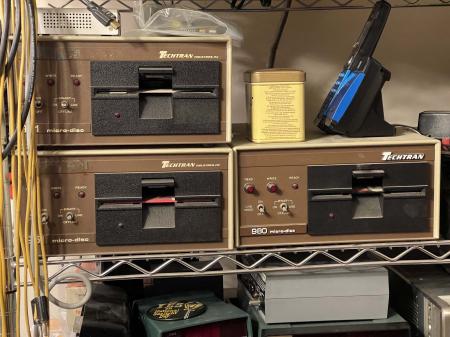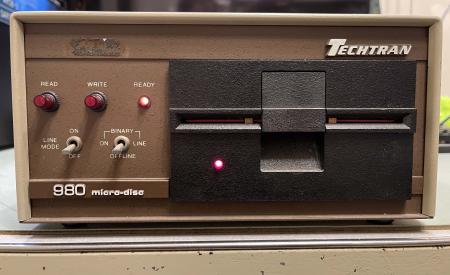- 2023
- Jan
- 7
The TechTran 980 standalone 5 1/4” disk drive.
So what is this thing?
One of the devices I’ve had kicking around the shop for years are these TechTran 900 series standalone disk drives. These were the main storage medium for a large test platform at a former employer. They would provide commands to a computerized telco switching frame in the form of responses to a “Read next record” command. When the project finally ended, I asked the project engineer for the drive. Turns out there were 4 units, with manuals and service information.


So, it’s a disk drive?
These have two modes. First is a “File” mode, which works like you’d expect from a mass storage device. You create a file, write to it, then read it back. It also has a “Record” mode - instead of writing files with a directory, these store records, much like a punch card would store a piece of information that may or may not be part of something larger. You would write and read records - bits of text - in sequential order.
The unit does this via a RS-232C interface, using text commands. The device can operate in standalone or passthru mode, and has all the normal serial settings you’d expect - except everything is done via switches that control what is literally a box full of 74LS chips.


How does it work?
Because the device was expected to be continually available while in operation, the manufacturer set these so the disk spins at all times, and the device loads the head on to the media whenever an operation is requested. This has the effect of only requiring the time to drop the head and wait for the record of interest to arrive at the head before the operation is completed. Normally, a drive would spin up, perhaps drop the head on the disk after it was spinning, seek the correct record in the directory, and then move to read it. These spent the majority of their life reading sequences, while the time savings was small it added up to all the years the unit was in operation. File operations, of course, required seeking the record in a directory, but there was still a small time savings in not having to spin the drive up each time.
This made for a very noisy device, as the fan was spinning, the drive was spinning, and the head was being loaded on and off the media surface over and over (with an accompanying clunk of the head load solenoid) each time. Not something you’d want in a quiet space, but the noise of the test frames generally overrode any noise this thing made.
Really?
Kind of. I’m digging into the service manual more because it has a theory of operation. It looks like the record mode does create “files,” but not quite in the same way as file mode. More on that as I understand it.
I have to say I’m somewhat surprised that these things still come up. I figured the belts would have long turned to goo at this point, and the fact they’ve been sitting since about 2000 probably hasn’t done them any good either. They had a long life, being put into operation in the early 1980s and running up to early 2000 or so. But spin up they did, attesting to the fact they were well engineered (aka cost a lot of 1980 dollars) and designed to last for a long time.
The one in the pictures, a Model 980, is going to be the subject of an attempt to make it talk to something modern, which shouldn’t be that difficult as it speaks serial. Set your baud rate to 1200 and stand by for further posts in this series.
Deleted the manuals for now, will package them up again soon!